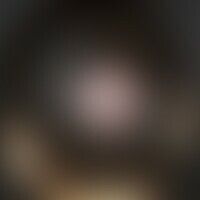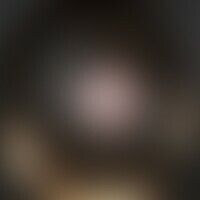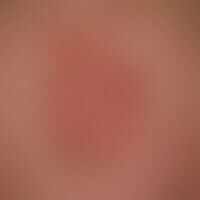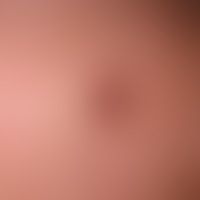Image diagnoses for "Scalp (hairy)"
120 results with 343 images
Results forScalp (hairy)

Ophiasis L63.2
Alopecia areata of the ophiasis type: Localization of the alopecia focus at the hairline in the neck with a wave-like pattern.

Favus B35.0
Favus: multiple asymptomatic plaques in a 6-year-old boy, existing since 4 weeks, sharply defined, clearly increased in consistency, with yellow scaly crusts.

Sarcoidosis of the skin D86.3
Sarcoidosis plaque form: large, symptom-free plaque on the capillitium that has existed for several years; scarred hairless state after healing under fumaric acid ester.

Pseudopélade L66.0
Pseudo-pelade: irregularly limited, hairless area. on enlargement (see inlet) it becomes clear that the follicular structure is completely missing in the hairless area. it is thus in a "scarred" final state of a previously expired inflammation leading to scarring.

Alopecia areata (overview) L63.8
Alopecia areata: Acute bullous contact allergic dermatitis after multiple treatment of the hairless areas with DNCB.

Cylindrome D23.4
Cylindrome: firmly elastic, hairless, red knot with a reflecting surface, interspersed with telangiectasia.

Trichorrhexis nodosa L67.0
trichorrhexis nodosa. calibre variations of the hairs. in the centre a thin hair with frayed shaft and broken axis. image taken in polarized light. in the inlet with arrow the fibrous hair breakage is marked

Bamboo hair Q80.8
Bamboo hair: characteristic hair shaft anomaly with ball-and-socket-like invagination of the hair shaft (hair shaft anomaly encircled) Microscopic image in polarized light.

Bamboo hair Q80.8
Bamboo hair: characteristic hair shaft anomaly with ball-and-socket-like invagination of the hair shaft; microscopic image in polarized light.

Tinea capitis (overview) B35.0
Tinea capitis superficialis:a slowly centrifugally growing, marginally dead centre that has been present for several months; pronounced marginal scaling; detection of Trichophyton mentagrophytes

Tinea capitis (overview) B35.0
Tinea capitis (microspores): diffuse infestation of the entire capillitium. only moderate itching. detection of Microspoum canis.

Microsphere B35.0
Tinea capitis superficialis caused by Microsporum canis: existing for several months, only moderately itching.

Superficial tinea capitis B35.0
Tineacapitis: extensive non-treated infection of the hairy and hairless scalp by Trichophyton mentagrophytes; known HIV infection.

Tinea capitis profunda B35.02
Tinea capitis profunda: Inflammatory, moderately itchy, slightly painful, fluctuating nodule in the area of the capillitium in children with extensive loss of hair.

Tinea capitis (overview) B35.0
Tinea capitis profunda: Inflammatory, moderately itchy, slightly painful, fluctuating nodule in the area of the capillitium in children with extensive loss of hair.

Superficial tinea capitis B35.0
Tinea capitis superficialis: multipe whitish scaly, moderately itchy papules and plaques. no pre-treatment.

Frontal fibrosing alopecia L66.8
Alopecia, postmenopausal, frontal, fibrosing: General view: Pronounced fronto-temporal scarring alopecia band-shaped frontal and diffuse parietal in a 71-year-old female patient (FFA grade V - clown alopecia). Rarefication of the eyebrows.

Alopecia areata (overview) L63.8
Alopecia areata (Grade 2-3): extensive loss of hair in the capillitium. at higher magnification, the preserved (hairless) follicles can be seen. preserved hair rings partly mark the grown alopecia foci. note individual re-grown pigment-free hairs

Carcinoma of the skin (overview) C44.L
Carcinoma kutanes:advanced, extensive ulcerated exophytic squamous cell carcinoma with massive actinic damage. 75-year-old man with androgenetic alopecia.

Psoriasis (Übersicht) L40.-
Psoriasis capitis: chronically inpatient red plaques extending beyond the hairline with discrete scaling (caused by pre-treatment). occasional itching

Fibroxanthoma atypical C49; D48.1
Fibroxanthoma atpyisches: rapidly growing, centrally ulcerated, painless lump in a man (>70 years) in actinically severely damaged skin.

Lupus erythematodes chronicus discoides L93.0
Lupus erythematodes chronicus discoides: older, only slightly active "discoid" lupus foci that heal under atrophy of skin and subcutis (focal destruction of hair follicles) Note the reddish-livid hue of the alopecic foci.

Merkel cell carcinoma C44.L
Merkel cell carcinoma: uncharacteristiccentrally deep ulcerated, plate-like lump, previously calotte-shaped growth.

